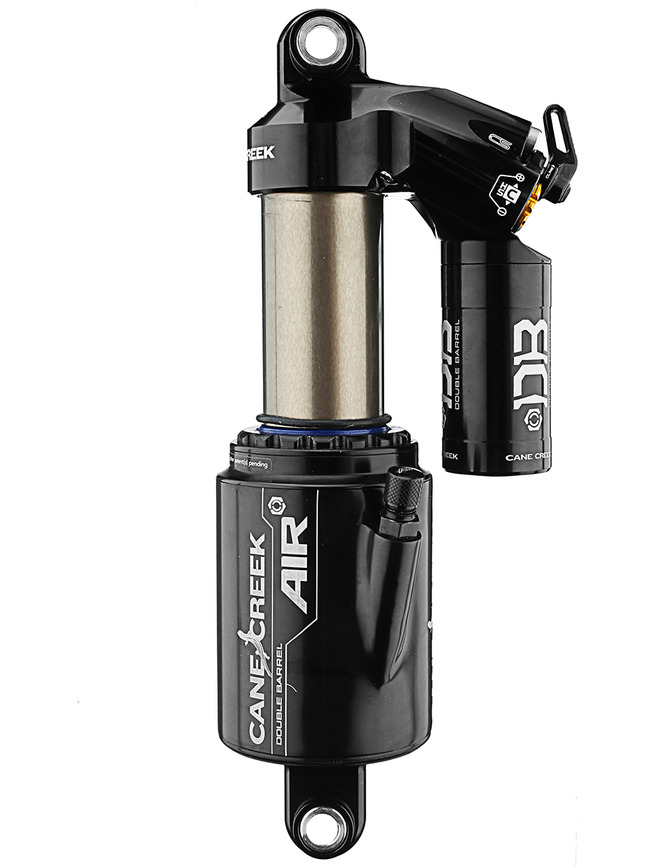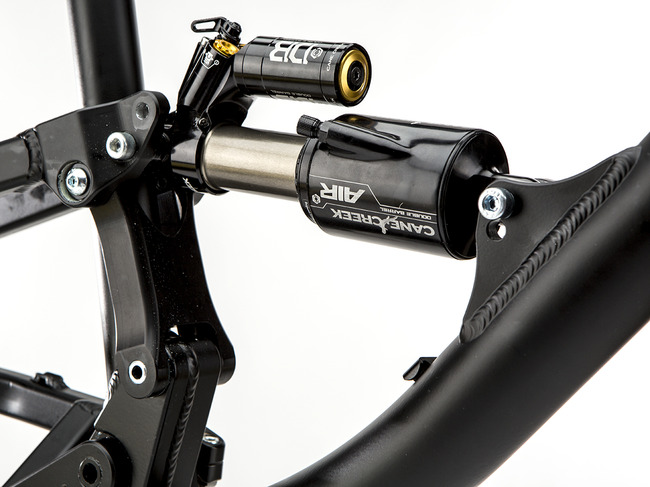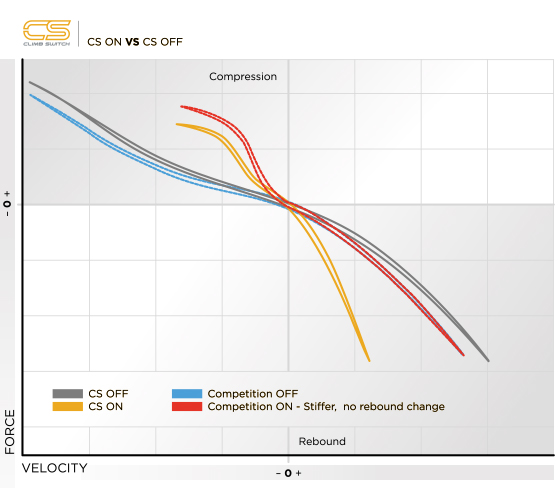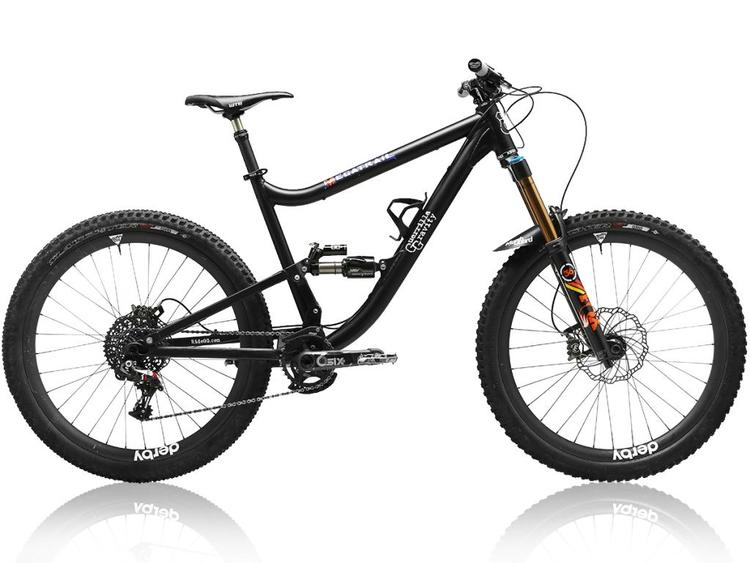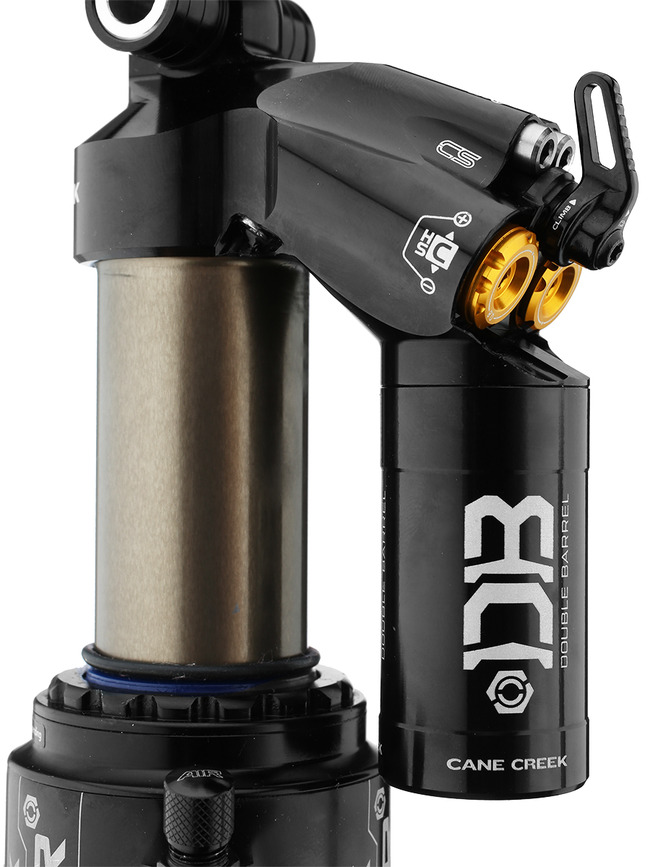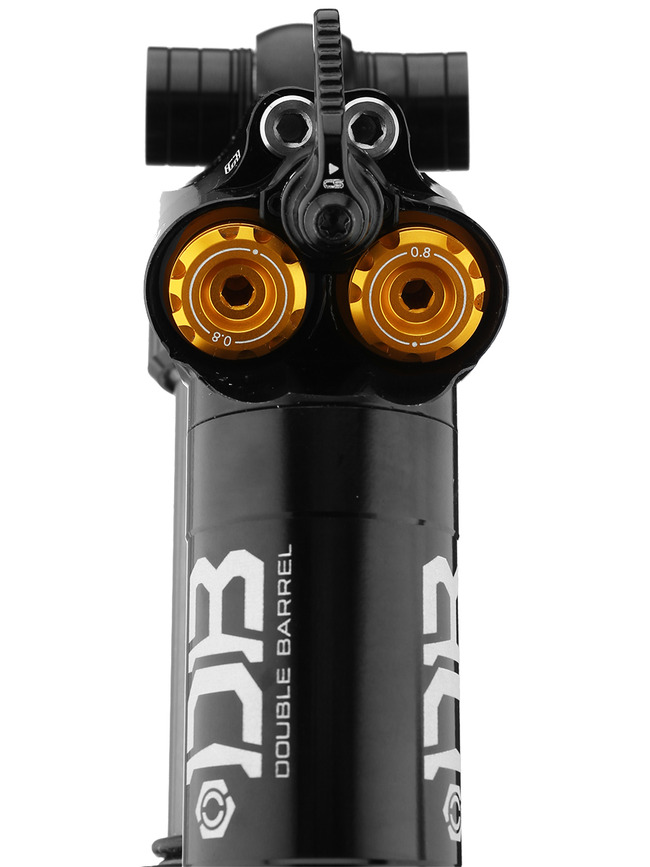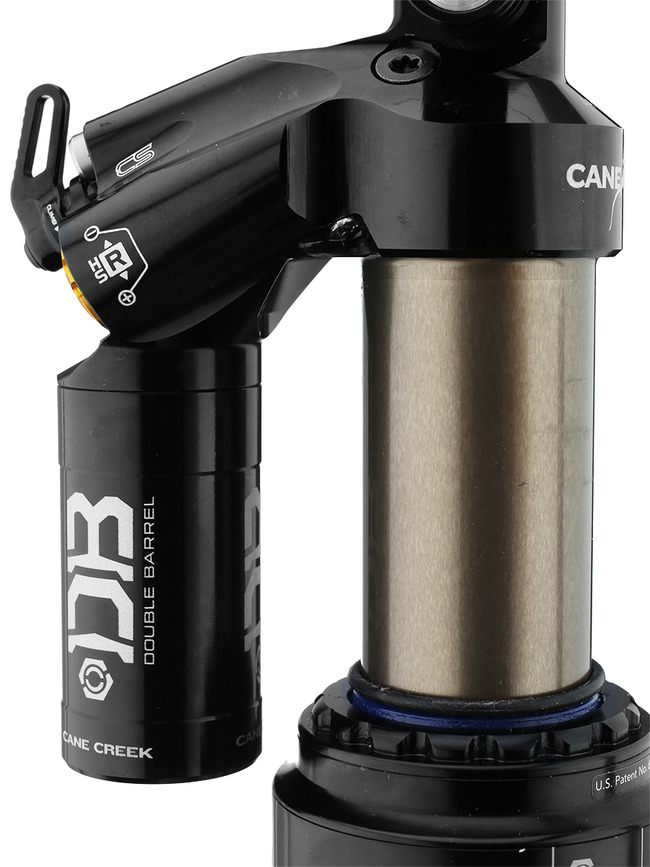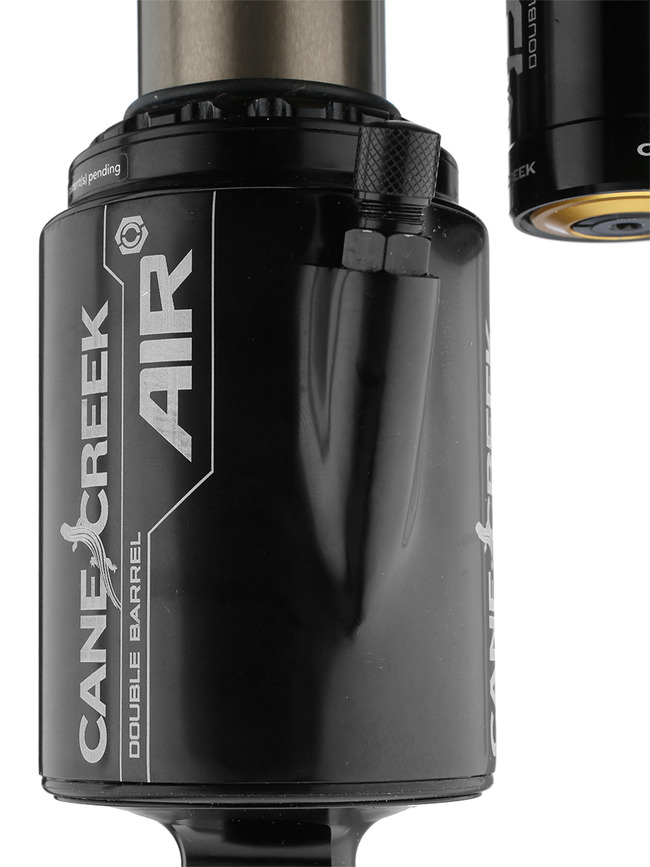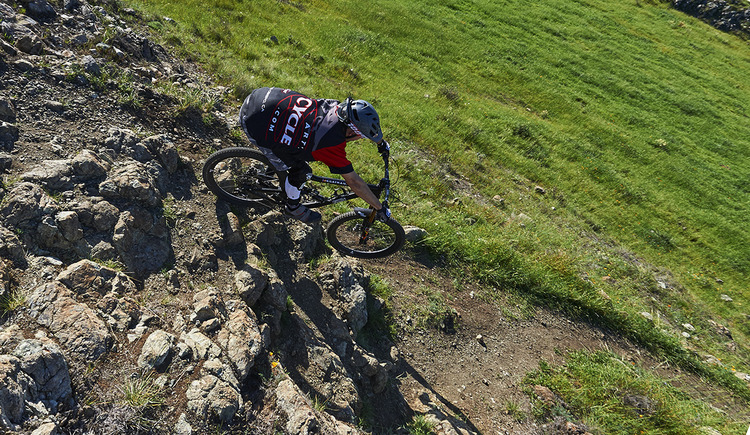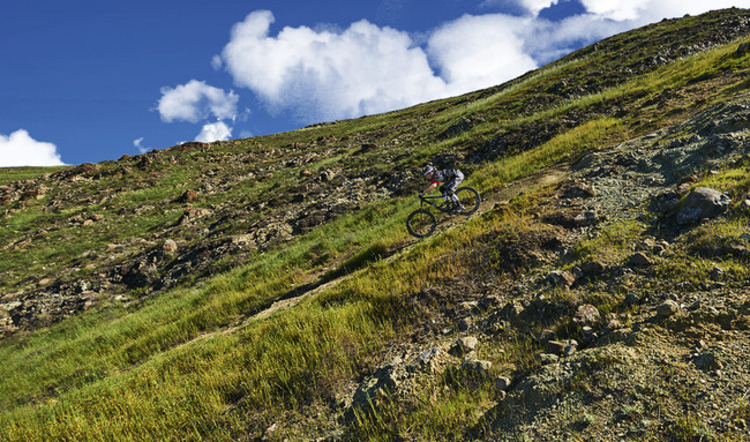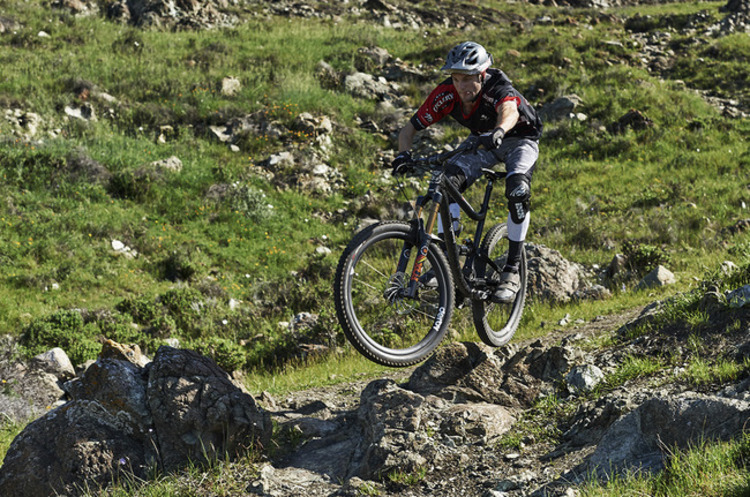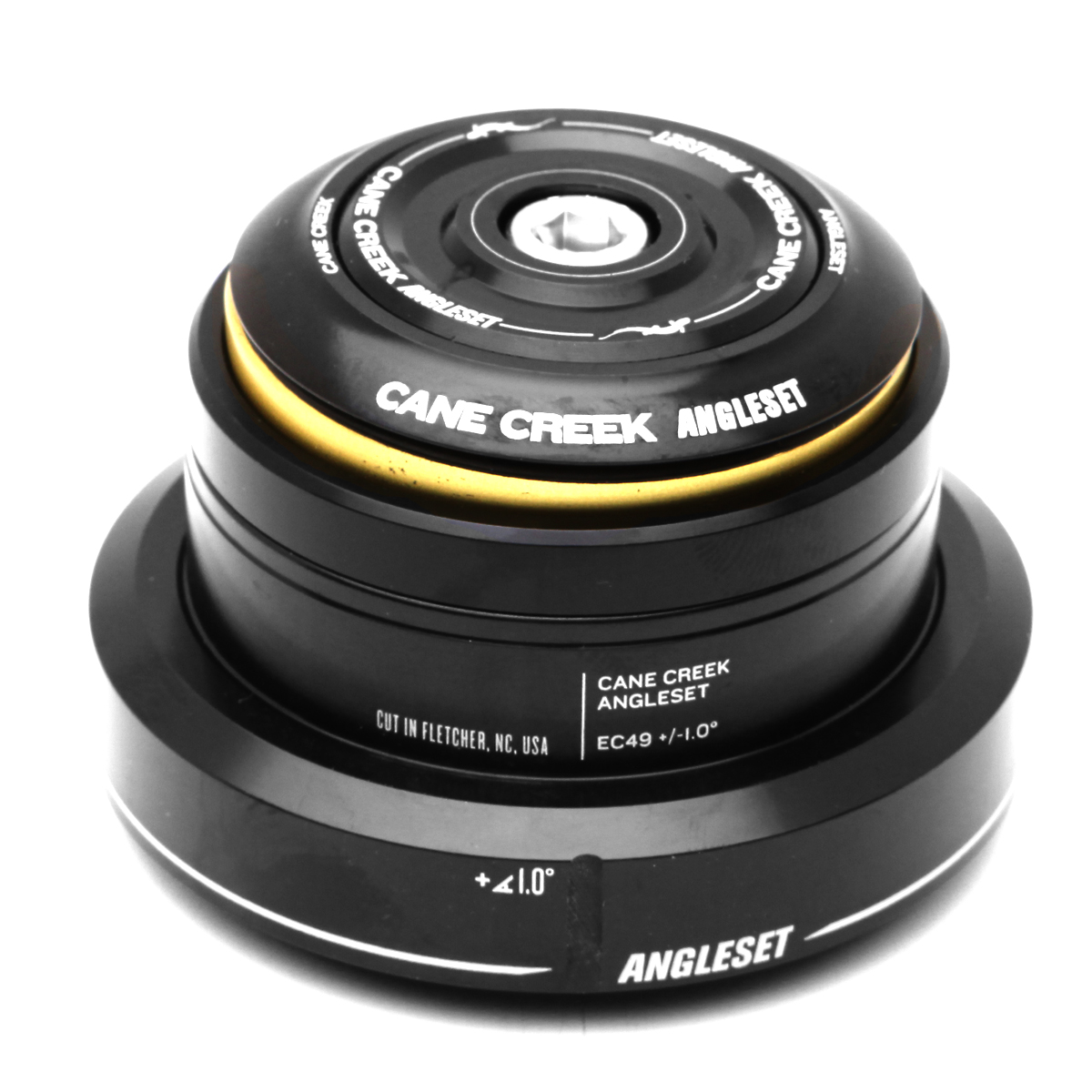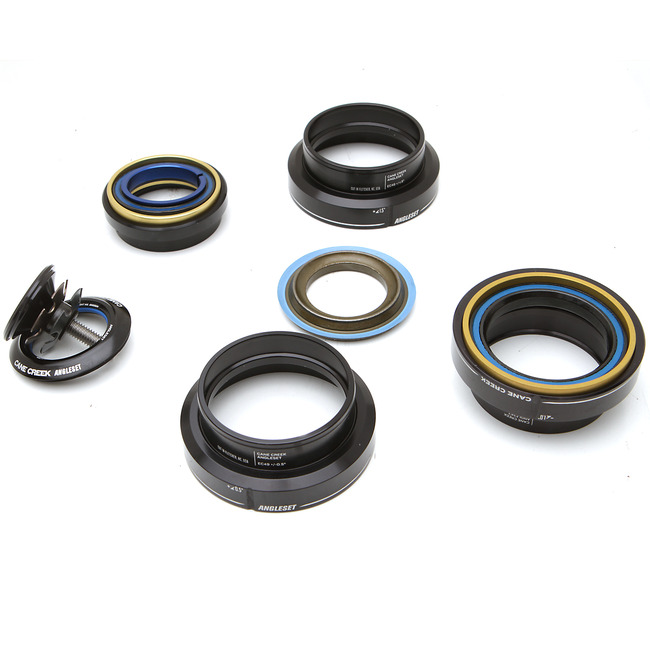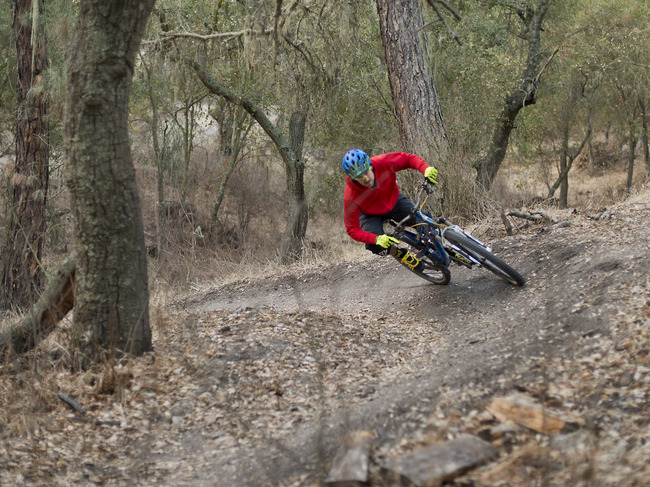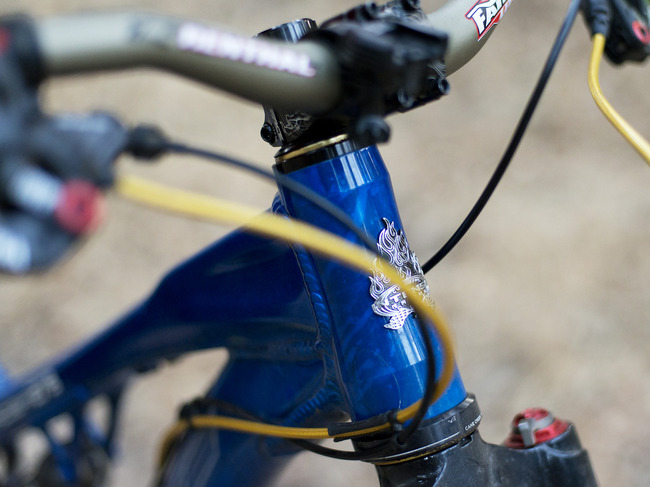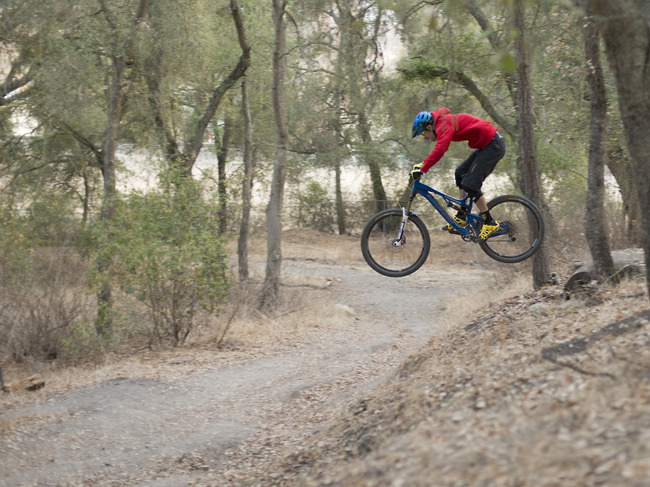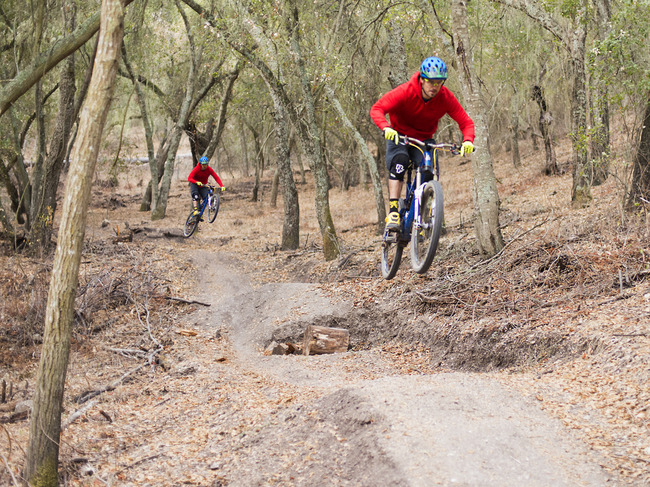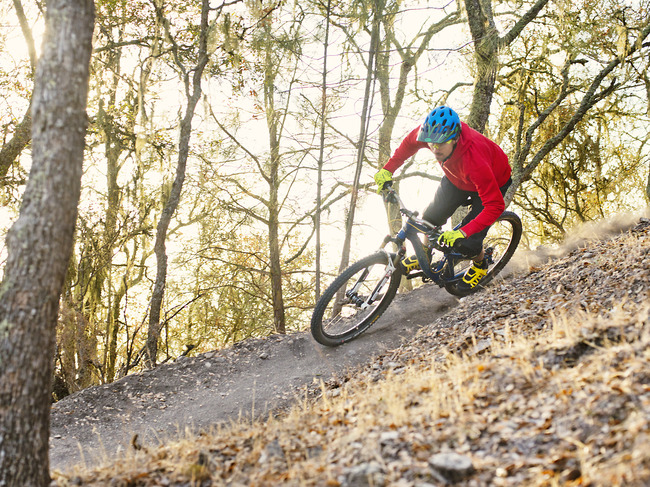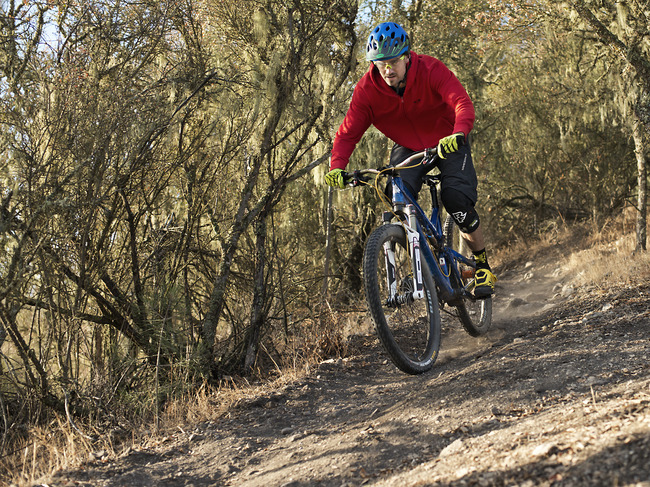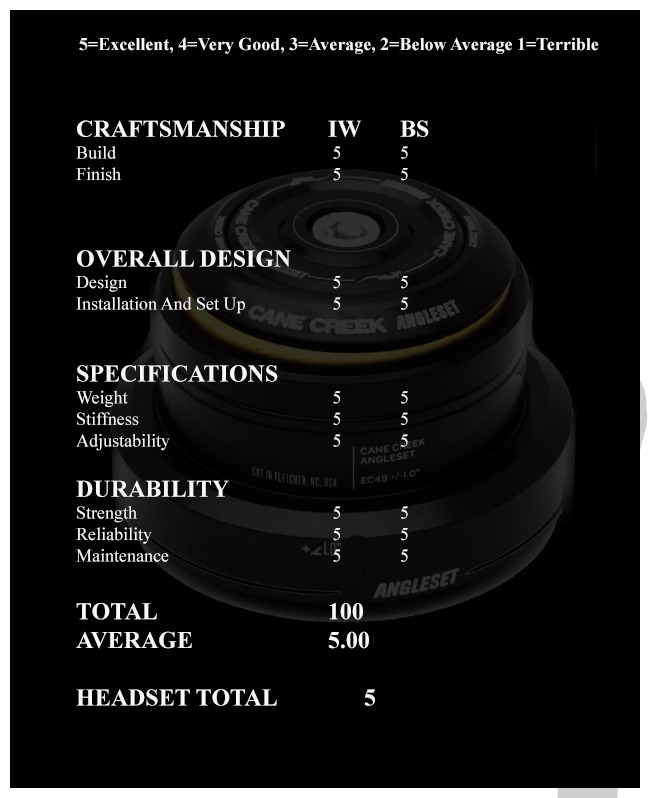CCDB AIR CS Shock Review
 Monday, January 26, 2015 at 10:51AM
Monday, January 26, 2015 at 10:51AM  Permalink
Permalink
Cane Creek introduced the Double Barrel Coil shock back in 2005. Thanks to 5th Element, Romic and Foes racing it became apparent that shocks that used some type of lock out or anti bob during sprints where to be the wave of the future. Many of these early generation shocks gave up mid stroke support in favor of pedaling performance. Frame designs have changed drastically in the last decade. With a strong push towards better pedaling efficiency and making the most out of smaller travel amounts. This was one aspect that helped in the creation of the modern long and low trail bike that would give many Downhill bikes from a decade ago a serious run for their money. Many shock manufactures have started creating larger volume air shocks with various Compression and Rebound adjustments on them to keep up with this new style of frame. Typically these will include some variant of a climb switch. Typically these effect the compression side of the shock. Cane Creek decided to split Compression and Rebound into two different adjustments in the form of Low and High speed variants. Their CS also alters both the compression and rebound side of the shock.
The CCDB Coil when released was not only very sensitive to small bumps it also helped minimize bob without slamming through its travel at the first sign of a high speed impact. Fast forward 8 years and suspension systems have become more refined and trail bikes much more capable. In 2013 Cane Creek released the CCDB Air CS (Climb Switch). This is a large volume air can shock which helps to keep the shock cool as the descents get longer and rougher. It gives up some weight against the inline version but for those looking for the ultimate in heavy duty trail bike air shocks it is the route to go. Something to consider is that the CCDB Air is so big around there are some frames on the market that cannot fit it so make sure you check before ordering one. If that is the case they also make a CCDB Inline that is a thinner configuration. The CS version of the shock includes a climb switch feature which essentially increase both compression and rebound and aids the bike while climbing.
CLIMBING SWITCH TECHNOLOGY
CS is the most innovative climbing feature available. This proprietary climbing feature (patent-pending) for Double Barrel shocks alters the entire low frequency dynamic response of the shock to specifically address the demands of ascending on a bicycle.
WHAT IS IT?
CS is a selectable climbing mode on Double Barrel shocks that allows the rider to retain the advantages of a fully-suspended bike while climbing, without unwanted suspension motion. CS is not your conventional pedal-platform as it adjusts both LSC and LSR. By selectively tuning both compression and extension phases when climbing, the shock maintains better traction and control while enhancing pedaling efficiency through the shock’s entire travel.
WHY IS IT BETTER?
The strength of CS lies in the fact that it provides climbing-specific chassis damping in both compression and rebound. The result is better rear-end traction and connection with the trail while minimizing annoying pedal-induced bob. Simply put – the rider is less fatigued and more comfortable. Traditional climbing “platforms” only deal with one half of the climbing dynamics, and thus require the rider's body to respond to the minimally damped rebound forces that are common during technical climbing.
HOW DOES IT WORK?
The Climb Switch changes the low speed damping of Double Barrel shocks in one simple switch, to optimize suspension dynamics during climbing. It does this by turning on and off a set of internal ‘climbing circuits’ that are accessed when CS is engaged. Cane Creek tunes the ‘climbing circuits’ specifically for the demands of off-road climbing to achieve improved pedaling efficiently with less chassis motion. When the rider is ready to descend, with the flip of CS, the shock returns to the traditional low-speed circuits of the Double Barrel.
To best illustrate the advantage of CS, we created the animation below using real data from dyno plots of a shock with CS off and then with CS on.
HOW IS IT DIFFERENT?
The CS feature on DB shocks completely alters the low-speed damping character of the shock. That is, CS changes compression and rebound damping simultaneously to mitigate unwanted chassis motion while climbing without compromising the traction and control one expects from a modern suspension bike. Other shocks with climbing specific adjustments only alter the compression behavior of the shock with no impact on rebound. The Dyno Chart below illustrates the the action of the DBAIR with CS ON and CS OFF as compared to the competition. A damper generates force in opposition to velocity. As velocity increases, so too does the force generated by the damper.
GRAPH OVERVIEW
The horizontal axis of this graph shows shaft speed (velocity). Negative velocity indicates the shaft is moving into the shock (compression) while positive velocity is extending the shock (rebound). The vertical axis represents force. Positive force is the force generated to resist compression and conversely negative force is the force generated to resist shaft extension (rebound force). In a nutshell, the upper left quadrant is compression, the bottom right is rebound. As velocity increases (moves away from the middle) the force increases.
CS ON VS. CS OFF
The grey line is a graph of a shock with CS Off and is indicative of a typical Double Barrel damper at a mid-range setting. The orange line is the CS ON setting and is much steeper than the grey line. This indicates that for the same shaft speed, the CS ON setting develops more force. In other words, the CS ON setting is stiffer and resists movement more than the CS OFF setting and both compression and rebound are affected. For the rider, this translates into better traction and control at low speeds.
TRADITIONAL CLIMBING PLATFORMS
The red line is a competitor's shock with the climb feature on and the blue line is the competitor's climb feature off. Most notably, the rebound curve overlaps because there is no change in rebound damping. The compression curve is steeper because our competitors require more compression damping to make a bike feel efficient by limiting the suspension movement. The rider's body is then required to respond to the minimally damped rebound forces and can experience less traction, less control and more fatigue.
CS stabilizes the suspension during both phases of the shock's travel - so your full suspension bike can be a full suspension bike all the time.
DBAIR CS TWIN TUBE TECHNOLOGY
Exclusive Twin Tube Technology circulates oil continuously through the damping valving to achieve highly controllable, independent damping for both compression and rebound strokes. This unique design moves oil through externally adjustable valving instead of the main piston, allowing for superior tunability and eliminating the need for internal valving changes to achieve proper shock setup. The video below explains this concept in more detail.
4 Way Adjustment
LSC is used to manage traction and chassis stabilization. LSC adjustment eliminates pedal induced "bob", influences small bump sensitivity, reduces brake dive and determines how the bike will react to weight changes. The DBAIR CS decouples LSC from HSC so the shock can address the aforementioned issues while still feeling plush and bottomless.
HSC is critical to absorbing energy from high impact forces, such as square edge hits and harsh landings. It also aids in bottom-out resistance. The DBAIR CS manages HSC through an adjustable poppet valve and full oil circuit flow path. The wide adjustment range allows for custom, rider-specific tuning.
LSR works in concert with LSC to stabilize the chassis and manage traction. It is analogous to the single rebound adjuster on most other rear shocks. Rider-tuned LSR adjustment (combined with LSC) ensures maximum traction during technical climbs, high-speed chatter, off-camber corners and braking in stutter bumps.
An adjustment unique to the DBAIR CS, HSR control enables a bike to recover quickly from deep in suspension travel while allowing for controlled take-offs from jump faces. Independent control of HSR and LSR, eliminates bucking (a high shaft speed problem) while preventing the shock from packing up (a low shaft speed problem) by inducing quick recovery.
CS is a proprietary climbing mode on DB shocks that changes the low speed damping via a set of internal "climbing circuits" when engaged. These circuits are tuned specifically for the demands of off-road climbing to achieve improved pedaling efficiency with less chasis motion.
We mounted the shock on a Guerrilla Gravity Megatrail. The shock came with all hardware and mounted easily. They include Air Can spacers that can be used to make the shock more progressive and the spacers come in a few different sizes, the taller ones having a bigger impact than the smaller ones. Having a shock with 2 rebound, and 2 compression adjustments can be overwhelming for some. It is much easier to mess up your bikes with this many adjustments so keep that in mind. Make adjustments slowly and do one at a time. Luckily a few years ago Cane Creek created the Base Tune feature on their website. It allows you to choose a frame and shock and gives you numbers to start from. They also have a Tuning Tips Section to show what each knob does and why. This is the third Cane Creek DB Air that we have used. The Base Tunes are very accurate we sped up our LSR a few clicks and added a hair of HSC and that was all! This will put a majority of people at a close to perfect starting point so use it.
SPECS
| WEIGHT | 509 grams (weight varies by size) |
| DAMPING | Twin-tube independent compression and rebound in two high-speed and four low-speed damping circuits |
| ADJUSTMENTS |
|
| SHAFT MATERIAL | Induction-hardened 4130 steel |
| SHAFT DIAMETER | 8mm |
| FINISH | Anodized and laser-etched |
| MOUNTING INTERFACE | Norglide® bushing 1/2" Universal Axle |
| CAN SIZE | Standard (All Lengths)Extra Volume (200, 216, 222, 240) |
Lengths
| 190 x 50mm (7.5” x 2.0”) |
| 200 x 50mm (7.87” x 2.0”) |
| 200 x 57mm (7.87 x 2.25”) |
| 216 x 63mm (8.5” x 2.5”) |
| 222 x 63mm (8.75” x 2.5”) |
| 222 x 70mm (8.75” x 2.75”) |
| 240 x 76mm (9.5” x 3.0”) |
| 267 x 90mm (10.5” x 3.5”) |
Cane Creek makes their product in the USA. Luckily we have never had to get any service done to our shocks in the past from Cane Creek but have heard they do provide quick service. This shock showed up at out door within 5 days of ordering it. If any help is needed getting the shock dialed they are just a phone call away. The other two CCDB Air shocks we have used have both been on DH bikes and neither of those where serviced in the time we had them. So they are pretty reliable.
1. How long has Cane Creek been in the suspension game?
Our suspension roots go back farther than you might suspect. In 1989 -while we were still Diacompe USA – we took on the manufacturing, distribution and sales of the RockShox® fork. Our first rear suspension product was the Air Driver series released in 1996 - bringing one of the first lightweight, air-sprung and air-
damped rear shocks to the market.
2. What other products do you guys make?
The Cane Creek Double Barrel line includes the DBinline, DBair, DBair CS, and DBcoil. Our other core products are our headsets (110-Series, 40-Series, 10-Series, AngleSet, and AER). Additionally, we offer Thudbuster suspension seatposts, Brakes, Bar Ends and Levers. *We manufacture all rear suspension
and premium headsets at our factory in North Carolina.
3. When designing the CCDB Air shock what where some of the goals with the shock?
At that point we knew we needed to expand our product line. The Double Barrel had won numerous awards and earned the stamp of quality and a fine reputation. With the DBair, we didn’t want to simply create an air version of the DBcoil – our engineers set out to address bikes used in DH applications yet specifically
designed for an air-dampened platform. In addition, the DBair had to maintain the DNA of the coil shock, be hand-built in our North Carolina factory, and ensure the highest level of performance and quality control the DB was known for. The resulting DBair shock maintains the quality of the DBcoil shock while giving the
riders who want a more progressive feel (instead of the linear feel of a coil shock) what they are looking for.
4. What made you guys decide to add the Climb Switch on the shock?
It’s safe to say that not addressing the climbing equation would have been a poor business decision. During initial testing our team built additional damping circuits on test shocks to try out the traditional approach. However, the added flexibility through the Double Barrel independent damping design allowed greater exploration into the effect each one had on climbing so that they could take it to a new level. They then asked the very simple question…Why not? Suspension utilizes the bike’s movement while allowing it to stay in control and connected with the ground. The end result was the expansion of Double Barrel suspension performance into climbing.
5. What is your recommended service interval for the shock?
See attached pages from the DB owners manual.
6. Can the customer rebuild the shock?
No – that magic is reserved for our Authorized Service Centers.
7. How many spacers can fit in the Air Can?
That depends on the rider. Our spacers come in a customizable grid sheet so a rider can cut it down to match their needs. See the attached card.
8. Will there be a Cane Creek fork or damper unit for other chassis at some point?
I haven’t seen a single Cane Creek engineer in months and I couldn’t get time from one for this interview – so it’s probably safe to say yes.
9. What type of trail rocks or jumps?
Jumps are way more fun.
10. Uphill or Downhill?
As long as it has “hill” in the name, I’m game.
11. What do you think the US MTB Race circuit needs to make it prosperous again?
Hmmm…good question. I’ll defer to the old adage that it takes money to make money. I once watched a European mountain bike race from my hotel in Sardinia, Italy at 6pm on a Friday. I didn’t understand a word that was being said but the simple fact that I could watch it on TV was amazing.
12. Who is the best ever MTB racer?
Ned Overend –I hear he doesn’t lock out his suspension either.
Ian W
Overall the CCDB Air did an excellent job on our Megatrail. The shock had great small bump compliance and is easy enough to keep from bottoming via HSC or adding air can spacers. Typically I like my suspension to be somewhat on the more linear side with a gradual rise towards the bottom of the travel. The Cane Creek Double Barrel Air managed that on our frame without needing to add any air can spacers into it. The bike handled small chatter very well it was very compliant and offered tons of traction. Once speeds picked up and the chunkier terrain was hitting fast and hard the shock did a great job of keeping it all under control. The action of the shock is great it responds fast and very consistently throughout its travel. Bigger hits where a non issue and we ended up slowing rebound down just a hair.
We pretty much ran the shock as they suggested on their Base Tune page and have been very happy with the results with only minor tweaks. There are pluses and minuses to needing tools to adjust the shock. It keeps you from making hasty adjustments while out on the trail or your friends messing with it in a lift line. But if by chance you wanted to slow down the rebound or add LSC you will need a tool to do so. This does help to keep the shock somewhat more slimmed down.
The Cane Creek Double Barrel Air shock is geared towards the gravity side of Enduro. Where descents are long, rough and the bike is making the most of its available suspension. In these instances smaller shocks will get warmer faster and damping will thus be negatively effected. We could have gone for the Inline version and saved some weight and ended up with a more lively bike with a more poppy feel. The CCDB Air likes to stay planted on the ground and maintain traction. The terrain we ride is very rocky, steep and demanding on suspension as a whole so we opted for the CCDB Air. The shocked proved very capable at keeping the bike planted on the rough, and steep terrain while providing traction when it was sorely needed.
Conclusion
Overall the CCDB Air CS did an excellent job of keeping the bike glued to the ground when the terrain got rowdy. Long descents seemed to have no adverse effect on the shock. The shock does an excellent job when when descending. The amount of tuning that the CCDB Air allows the user is vast. All the adjustments have a fair number of clicks. They offer a very comprehensive set-up guide on their website based on specific frame brands. This is a very good place to start.
Cane Creek's creation of the Climb Switch is very functional. The bike will still use its travel but with a much stronger platform and somewhat slower rebound. These combined to make a very capable climber out of a slacked out long travel trail bike. Those suspension designs out there that don't provide a strong pedaling platform can benefit greatly from the CS feature alone. The CCDB AIR CS shock climbs as well as it descends!
Cane Creek has produced one of the best air shocks on the market with the CCDB Air and adding the CS feature to it will open the door for it to make frames with inferior pedaling characteristics much better at going uphill! There are a number of air shocks currently on the market but the Double Barrel Air is the one we would recommend to a friend without hesitation.
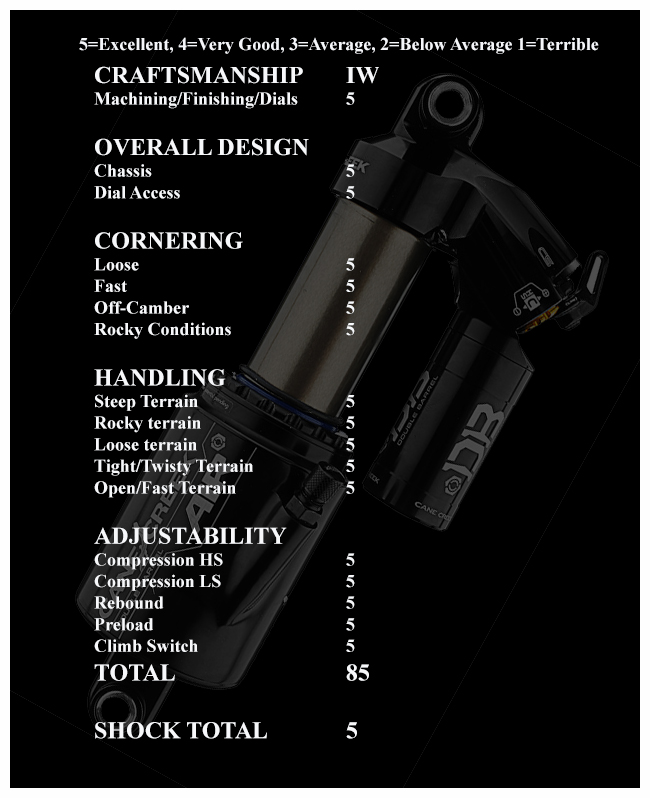
 CCDB,
CCDB,  CCDB AIR CS,
CCDB AIR CS,  CCDB Air,
CCDB Air,  CS,
CS,  Can Creek Double Barrel Air,
Can Creek Double Barrel Air,  Cane Creek,
Cane Creek,  Climb Switch |
Climb Switch |





